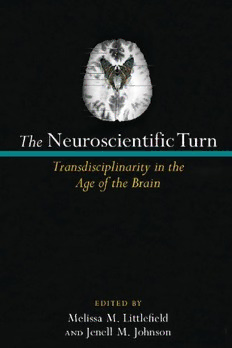Table Of ContentThe Neuroscientific Turn
The Neuroscientific Turn
Transdisciplinarity in the
Age of the Brain
Melissa M. Littlefield
and
Jenell M. Johnson
Editors
The University of Michigan Press
Ann Arbor
Copyright © by the University of Michigan 2012
All rights reserved
This book may not be reproduced, in whole or in part, including illustrations,
in any form (beyond that copying permitted by Sections 107 and 108 of the
U.S. Copyright Law and except by reviewers for the public press), without
written permission from the publisher.
Published in the United States of America by
The University of Michigan Press
Manufactured in the United States of America
c Printed on acid- free paper
2015 2014 2013 2012 4 3 2 1
A CIP catalog record for this book is available from the British Library.
Library of Congress Cataloging- in- Publication Data
The neuroscientific turn : transdisciplinarity in the age of the brain / Melissa M. Littlefield
and Jenell M. Johnson, editors.
p. ; cm.
Includes bibliographical references and index.
ISBN 978- 0- 472- 11826- 7 (hardback : alk. paper) — ISBN 978- 0- 472- 02835- 1
(e- book)
I. Littlefield, Melissa M., 1979– II. Johnson, Jenell M., 1978–
[DNLM: 1. Neuroscience. WL 100]
612.8— dc23 2012011048
To Susan M. Squier, for opening doors
Acknowledgments
We are, first and foremost, thankful to our collaborators in this project:
the authors who wrote and revised essays for this volume, and who dis-
played their willingness to transgress boundaries, to be innovative, and to
ask important questions. Our sincere gratitude to those who read part or
all of the manuscript: Spencer Schaffner, Justine Murison, Kate Viera, and
the anonymous reviewers. We would also like to thank Andrew Shail, Bob
Markley, Susan Squier, Hugh Crawford, and Laura Otis for offering advice
along the way. Thanks also to Martyn Pickersgill and Ira van Keulen for
helping to shape our ideas about popular neuroscience. Finally, thanks to
our terrific research assitants, Jessica Mercado and Megan Condis.
Beyond these individuals, we are indebted to two organizations: the
Society for Literature, Science, and the Arts (SLSA) and the European
Neuroscience and Society Network (ENSN). For the past decade, SLSA
has provided both the occasion to delve into many of the questions that
inform this collection and the audience to engage with them. SLSA was lit-
erally our meeting place: where we pored over submitted abstracts among
coffee and crumbs in Atlanta, where we presented our ideas for the col-
lection on a panel with Sarah Birge, where we pitched the book to Tom
Dwyer over lunch in Indianapolis. ENSN has been our source of all things
“neuro,” from Neuroschool to fMRI experiments, and the people we have
met through this collaborative effort have forever changed our perspec-
tives about what it means to work interdisciplinarily—o r better yet, trans-
disciplinarily. In particular, we would like to thank Nikolas Rose, Giovanni
Frazzetto, Klaus- Peter Lesch, and Andreas Roepsdorff for their insight,
for opening their laboratories, and for loosening their purse strings so that
we could learn about neuroscience and work with technologies like MRI
scanners and PCR.
In addition, we want to offer our thanks to Tom Dwyer, Alexa Ducsay,
viii • Acknowledgments
Christina Milton, and members of the University of Michigan Press’s edi-
torial and production staff for producing a beautiful volume. This collec-
tion would not be possible without the support of the University of Illinois
Research Board and the Department of English. Finally, we would also like
to acknowledge and commemorate Susan Leigh Star, who passed away in
March 2010. Leigh had agreed to contribute an essay to this volume, and,
though the collection is full of wonderful chapters, hers is sorely missed.
Melissa would like to thank Jenell for her tireless work, her amazing
scholarship, and her sense of humor. This volume was the collaboration
of friends long before it was a scholarly collection. Thanks also to Des
Fitzgerald, Martin Dietz, Kasper Knudsen, and James Tonks for collabo-
rating in all things fMRI; to the graduate students in my Neuroscience and
Humanities course for their insightful comments; to John Littlefield, Val-
erie Perialas, and Jonathan Littlefield for their tireless support; and, finally,
to Isaac Sosnoff and Spencer Schaffner: Σ’αγαπώ.
Jenell would like to first thank Melissa: trusted coauthor, meticulous
coeditor, and dear friend. Thanks also to Alison Cool, Daniel Stjepanović,
Morten Bülow, and my other Würzburg neuroschoolmates; my colleagues
at Louisiana State University (especially Lillian Bridwell-B owles) and the
University of Wisconsin- Madison (especially Rob Asen, Karma Chávez,
Jonathan Gray, Rob Howard, Eunjung Kim, Steve Lucas, Sara McKinnon,
Ellen Samuels, Walt Schalick, and Sue Zaeske). My gratitude to Megan
Zuelsdorff for countless hours of brain-y conversations and for introduc-
ing me to neurotheology many years ago. Thanks to my family: James
Johnson, Joy Johnson, Jenna Johnson, Jodi Carreon, and Ryan Carreon, for
their constant support. And, finally, my deepest thanks to Michael Xenos,
my best critic and biggest fan.
Contents
Preface: A Neuro- Pivot xi
judy illes
Introduction: Theorizing the Neuroscientific Turn— Critical
Perspectives on a Translational Discipline 1
Melissa M. Littlefield and Jenell M. Johnson
Part 1. The Neuroscientific Turn in Context
1. “The Paradise of Non- Experts”: The Neuroscientific Turn
of the 1840s United States 29
Justine S. Murison
2. The Performativity of a Historical Brain Event:
Revisiting 1517 Strassburg 49
Jameson Kismet Bell
3. The Neural Metaphor 71
Kélina Gotman
Part 2. The Neuroscientific Turn in Practice
4. Brainhood, Selfhood, or “Meat with a Point of View”:
The Value of Fiction for Neuroscientific Research
and Neurological Medicine 89
Sarah Birge
5. Neuroscience and the Quest for God 105
Scott E. Hendrix and Christopher J. May

